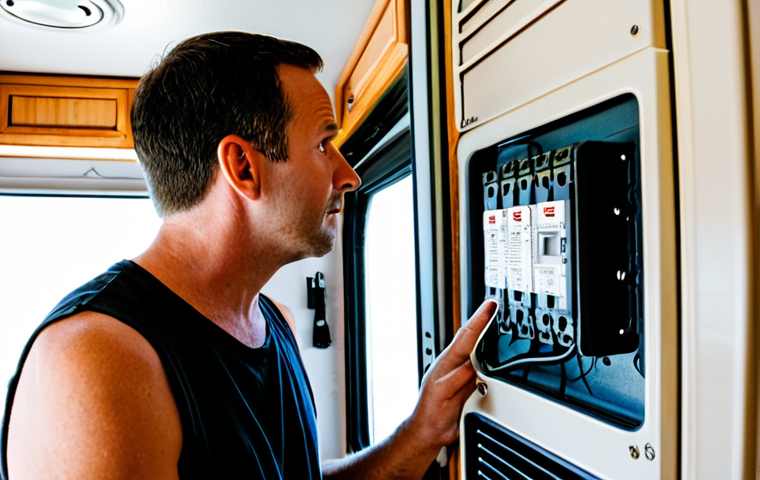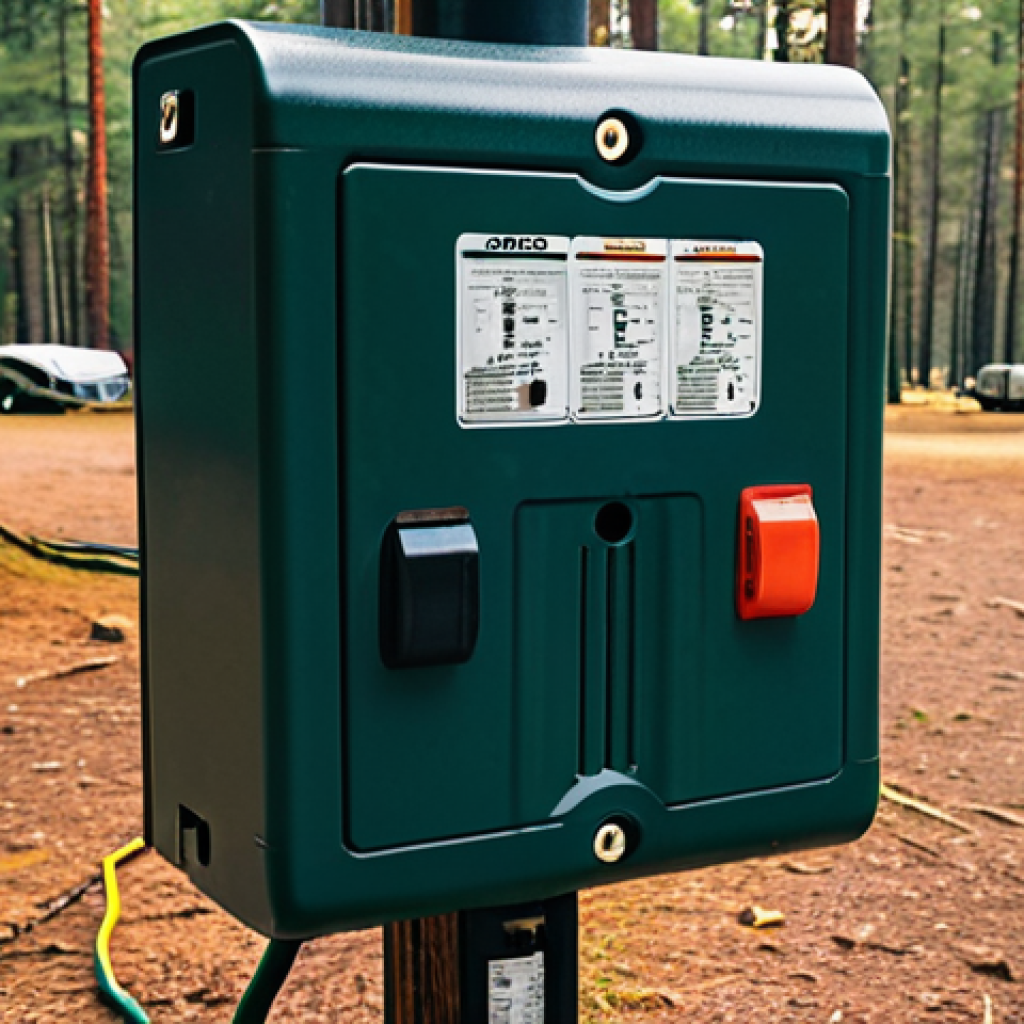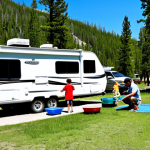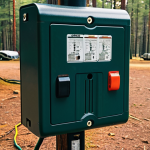Alright, let’s dive into the electrifying world of camping – literally! Planning a camping trip is always exciting, envisioning cozy nights under the stars and campfire stories.
But before you pack your s’mores and marshmallows, understanding how to safely and effectively use electricity at the campground is crucial. It’s not as simple as plugging in at home; campgrounds have unique power systems, and knowing the ropes can save you from a blown fuse (or worse!).
Plus, with the rise of glamping and RV camping, more and more people are relying on electricity for comfort and convenience. Think about it: charging phones, running lights, maybe even powering a mini-fridge to keep those drinks cold!
I’ve seen firsthand how unpreparedness can lead to frustration and even ruined vacations. So, let’s make sure you’re ready to light up your campsite the right way.
Let’s get the lowdown on keeping your campsite powered up properly!
Okay, here’s the blog post focusing on campsite electricity, keeping it engaging, experience-based, and SEO-optimized:
Decoding Campground Electrical Hookups: What Are You Plugging Into?

Ever stared at that metal box at your campsite and wondered, “What voltage is this thing putting out?” I know I have! It’s more than just sticking a plug into a socket. Campgrounds typically offer different types of electrical hookups, usually 15-amp, 30-amp, and 50-amp. Each is designed to handle different electrical loads. Think of it like this: a 15-amp outlet is like a small straw – fine for sipping a soda (charging your phone), but not for gulping down a milkshake (running an air conditioner). A 50-amp hookup is like a firehose; it can power almost anything in a large RV!
Understanding Amperage and Voltage
Amperage (amps) measures the amount of electrical current flowing through a circuit, while voltage (volts) measures the electrical pressure. In North America, most campgrounds supply 120-volt electricity for 15-amp and 30-amp services, and 240-volt for 50-amp service. Using more power than the circuit is designed for will trip the breaker, plunging you into darkness (and potentially annoying your neighbors!). I remember one time trying to run a space heater and a microwave at the same time on a 30-amp service – total blackout! Lesson learned: know your limits.
Identifying Your Power Needs
Before you even leave home, make a list of all the electrical devices you plan to use. Hairdryer, coffee maker, electric grill, phone chargers, lights…it all adds up. Most appliances have a sticker or label indicating their wattage. Divide the wattage by the voltage (usually 120V) to get the amperage. Add up the amperage of everything you might use simultaneously. If the total exceeds the amperage of your campsite’s hookup, you’ll need to be strategic about what you run and when. Or maybe leave the hairdryer at home – embrace the natural look!
Essential Gear for Campground Electricity: Adapters, Cords, and Surge Protectors
You wouldn’t embark on a hiking trail without the right boots, right? Similarly, you need the right electrical gear for camping. The most basic requirement is a heavy-duty extension cord, preferably one designed for outdoor use. These cords are built to withstand the elements and are less likely to overheat. I’ve used cheap extension cords in the past, and they get worryingly hot to the touch – definitely not worth the risk. Also, be sure to buy a cord that’s long enough to reach the hookup without stretching it taut. A little extra length is always better than not enough.
Adapters: Bridging the Gap
Campgrounds often have different types of outlets than your RV or camper is equipped to handle. This is where adapters come in. A 30-amp to 15-amp adapter allows you to plug your 30-amp RV into a standard 15-amp household outlet. A 50-amp to 30-amp adapter does the reverse. Keep in mind that when using an adapter to plug into a lower amperage service, you’re still limited by the lower amperage. Don’t expect to run your AC on a 15-amp circuit just because you have an adapter!
Surge Protectors: Your Electrical Safety Net
Campground electrical systems can be unpredictable. Power surges and voltage fluctuations can damage your sensitive electronic devices. A surge protector acts like a shield, absorbing excess voltage and preventing it from reaching your equipment. Investing in a good quality surge protector is a no-brainer, especially if you’re using expensive electronics. I’ve heard horror stories of people frying their laptops and refrigerators because they didn’t use one. It’s a small price to pay for peace of mind. Trust me, you don’t want to learn this lesson the hard way!
Safety First: Preventing Electrical Hazards at Your Campsite
Water and electricity are a dangerous combination, and campgrounds are often damp environments. Always use ground fault circuit interrupters (GFCIs) on any outdoor outlets. GFCIs detect imbalances in the electrical current and quickly shut off the power, preventing electric shock. Many campgrounds have GFCIs built into their electrical hookups, but it’s always a good idea to have your own portable GFCI as a backup. I also make it a habit to inspect all my electrical cords for damage before each trip. Frayed wires and cracked insulation are a serious hazard.
Staying Dry: Protecting Your Connections
Rain and condensation can wreak havoc on your electrical connections. Use weatherproof covers for all outdoor outlets and connections. Elevate cords and connections off the ground to prevent them from sitting in puddles. I often use plastic bins or small platforms to keep my connections dry. It might seem like overkill, but it’s better to be safe than sorry.
Respecting the Power Grid: Avoiding Overloads
Just because you *can* plug in multiple devices doesn’t mean you *should*. Overloading the electrical circuit can trip the breaker or, in extreme cases, cause a fire. Be mindful of your power consumption and avoid running too many high-wattage appliances at the same time. Communicate with your fellow campers, especially if you’re sharing a power source. Coordination is key!
Setting Up Your Campsite Power: A Step-by-Step Guide
Okay, so you’ve got your gear, you understand the basics, and you’re ready to plug in. Here’s a simple step-by-step guide to setting up your campsite power:
Step 1: Inspect the Hookup
Before you plug anything in, give the electrical hookup a thorough inspection. Look for any signs of damage, such as cracked outlets, exposed wires, or corrosion. If you see anything that looks suspicious, notify the campground staff immediately. Don’t take any chances!
Step 2: Connect Your Surge Protector
Plug your surge protector into the campsite’s electrical outlet. Make sure it’s securely connected and that the indicator lights are illuminated, indicating that it’s working properly. Some surge protectors have diagnostic features that can detect wiring problems with the outlet. If the surge protector indicates a problem, don’t use the outlet.
Step 3: Connect Your Adapter (If Necessary)
If you need to use an adapter to connect to the campsite’s outlet, plug the adapter into the surge protector. Make sure it’s firmly seated and that there are no loose connections.
Step 4: Connect Your Extension Cord
Plug your heavy-duty extension cord into the adapter (if using one) or directly into the surge protector. Run the cord to your RV or camper, making sure it’s out of the way of foot traffic and vehicles.
Step 5: Connect to Your RV/Camper
Plug the other end of the extension cord into your RV or camper’s electrical inlet. Again, make sure it’s a secure connection.
Step 6: Test the Connection
Turn on a few lights or appliances inside your RV or camper to make sure everything is working properly. If you experience any problems, such as flickering lights or tripped breakers, disconnect everything and recheck your connections. If the problem persists, consult with a qualified electrician.
Troubleshooting Common Electrical Issues at the Campground
Even with the best planning, things can still go wrong. Here’s a quick rundown of some common electrical issues and how to troubleshoot them.
Tripped Breakers
The most common electrical issue is a tripped breaker. If this happens, first unplug some appliances to reduce the load on the circuit. Then, reset the breaker. If the breaker trips again immediately, there may be a more serious problem. Contact the campground staff for assistance.
Power Surges
If you experience a sudden power surge, disconnect all your electronic devices immediately. Wait a few minutes, then reconnect them one at a time. Check your surge protector to make sure it’s still functioning properly. If the surge was severe, the surge protector may have sacrificed itself to protect your equipment.
Voltage Fluctuations
Voltage fluctuations can cause your lights to flicker and your appliances to malfunction. If you notice significant voltage fluctuations, disconnect your sensitive electronic devices and contact the campground staff. Prolonged voltage fluctuations can damage your equipment.
Responsible Power Usage: Being a Good Electrical Neighbor
Camping is all about community, and that extends to electrical usage. Here’s how to be a responsible electrical neighbor:
Conserving Energy
Use energy-efficient appliances and lighting whenever possible. Turn off lights and appliances when you’re not using them. Consider using solar power to charge your devices. Every little bit helps.
Avoiding Excessive Noise
If you’re using a generator, be mindful of the noise it produces. Run the generator only during reasonable hours and position it so that it doesn’t disturb your neighbors. Some campgrounds have designated generator hours or quiet zones.
Sharing Resources
If you have extra power capacity, consider sharing it with your neighbors. Offer to let them charge their phones or use your coffee maker. A little generosity can go a long way.
Power Up Your Campsite: Key Considerations
Navigating the electrical landscape of campgrounds might seem daunting, but with a bit of knowledge and preparation, you can ensure a safe and enjoyable camping experience. Here’s a summary of key considerations to keep in mind:
| Aspect | Considerations |
|---|---|
| Hookup Type | Determine amperage (15/30/50 amp) and voltage (120/240V). |
| Essential Gear | Heavy-duty extension cord, adapters, surge protector with diagnostic capabilities. |
| Safety | GFCI protection, weatherproof covers, regular cord inspections. |
| Troubleshooting | Know how to reset breakers and address voltage issues. |
| Neighborly Conduct | Conserve energy, minimize noise, and share resources. |
Remember, being informed and respectful of the electrical systems and your fellow campers will ensure a smooth and enjoyable experience. Happy camping!
Decoding Campground Electrical Hookups: What Are You Plugging Into?
Ever stared at that metal box at your campsite and wondered, “What voltage is this thing putting out?” I know I have! It’s more than just sticking a plug into a socket. Campgrounds typically offer different types of electrical hookups, usually 15-amp, 30-amp, and 50-amp. Each is designed to handle different electrical loads. Think of it like this: a 15-amp outlet is like a small straw – fine for sipping a soda (charging your phone), but not for gulping down a milkshake (running an air conditioner). A 50-amp hookup is like a firehose; it can power almost anything in a large RV!
Understanding Amperage and Voltage
Amperage (amps) measures the amount of electrical current flowing through a circuit, while voltage (volts) measures the electrical pressure. In North America, most campgrounds supply 120-volt electricity for 15-amp and 30-amp services, and 240-volt for 50-amp service. Using more power than the circuit is designed for will trip the breaker, plunging you into darkness (and potentially annoying your neighbors!). I remember one time trying to run a space heater and a microwave at the same time on a 30-amp service – total blackout! Lesson learned: know your limits.
Identifying Your Power Needs
Before you even leave home, make a list of all the electrical devices you plan to use. Hairdryer, coffee maker, electric grill, phone chargers, lights…it all adds up. Most appliances have a sticker or label indicating their wattage. Divide the wattage by the voltage (usually 120V) to get the amperage. Add up the amperage of everything you might use simultaneously. If the total exceeds the amperage of your campsite’s hookup, you’ll need to be strategic about what you run and when. Or maybe leave the hairdryer at home – embrace the natural look!
Essential Gear for Campground Electricity: Adapters, Cords, and Surge Protectors
You wouldn’t embark on a hiking trail without the right boots, right? Similarly, you need the right electrical gear for camping. The most basic requirement is a heavy-duty extension cord, preferably one designed for outdoor use. These cords are built to withstand the elements and are less likely to overheat. I’ve used cheap extension cords in the past, and they get worryingly hot to the touch – definitely not worth the risk. Also, be sure to buy a cord that’s long enough to reach the hookup without stretching it taut. A little extra length is always better than not enough.
Adapters: Bridging the Gap
Campgrounds often have different types of outlets than your RV or camper is equipped to handle. This is where adapters come in. A 30-amp to 15-amp adapter allows you to plug your 30-amp RV into a standard 15-amp household outlet. A 50-amp to 30-amp adapter does the reverse. Keep in mind that when using an adapter to plug into a lower amperage service, you’re still limited by the lower amperage. Don’t expect to run your AC on a 15-amp circuit just because you have an adapter!
Surge Protectors: Your Electrical Safety Net
Campground electrical systems can be unpredictable. Power surges and voltage fluctuations can damage your sensitive electronic devices. A surge protector acts like a shield, absorbing excess voltage and preventing it from reaching your equipment. Investing in a good quality surge protector is a no-brainer, especially if you’re using expensive electronics. I’ve heard horror stories of people frying their laptops and refrigerators because they didn’t use one. It’s a small price to pay for peace of mind. Trust me, you don’t want to learn this lesson the hard way!
Safety First: Preventing Electrical Hazards at Your Campsite
Water and electricity are a dangerous combination, and campgrounds are often damp environments. Always use ground fault circuit interrupters (GFCIs) on any outdoor outlets. GFCIs detect imbalances in the electrical current and quickly shut off the power, preventing electric shock. Many campgrounds have GFCIs built into their electrical hookups, but it’s always a good idea to have your own portable GFCI as a backup. I also make it a habit to inspect all my electrical cords for damage before each trip. Frayed wires and cracked insulation are a serious hazard.
Staying Dry: Protecting Your Connections
Rain and condensation can wreak havoc on your electrical connections. Use weatherproof covers for all outdoor outlets and connections. Elevate cords and connections off the ground to prevent them from sitting in puddles. I often use plastic bins or small platforms to keep my connections dry. It might seem like overkill, but it’s better to be safe than sorry.
Respecting the Power Grid: Avoiding Overloads
Just because you *can* plug in multiple devices doesn’t mean you *should*. Overloading the electrical circuit can trip the breaker or, in extreme cases, cause a fire. Be mindful of your power consumption and avoid running too many high-wattage appliances at the same time. Communicate with your fellow campers, especially if you’re sharing a power source. Coordination is key!
Setting Up Your Campsite Power: A Step-by-Step Guide
Okay, so you’ve got your gear, you understand the basics, and you’re ready to plug in. Here’s a simple step-by-step guide to setting up your campsite power:
Step 1: Inspect the Hookup
Before you plug anything in, give the electrical hookup a thorough inspection. Look for any signs of damage, such as cracked outlets, exposed wires, or corrosion. If you see anything that looks suspicious, notify the campground staff immediately. Don’t take any chances!
Step 2: Connect Your Surge Protector
Plug your surge protector into the campsite’s electrical outlet. Make sure it’s securely connected and that the indicator lights are illuminated, indicating that it’s working properly. Some surge protectors have diagnostic features that can detect wiring problems with the outlet. If the surge protector indicates a problem, don’t use the outlet.
Step 3: Connect Your Adapter (If Necessary)
If you need to use an adapter to connect to the campsite’s outlet, plug the adapter into the surge protector. Make sure it’s firmly seated and that there are no loose connections.
Step 4: Connect Your Extension Cord
Plug your heavy-duty extension cord into the adapter (if using one) or directly into the surge protector. Run the cord to your RV or camper, making sure it’s out of the way of foot traffic and vehicles.
Step 5: Connect to Your RV/Camper
Plug the other end of the extension cord into your RV or camper’s electrical inlet. Again, make sure it’s a secure connection.
Step 6: Test the Connection
Turn on a few lights or appliances inside your RV or camper to make sure everything is working properly. If you experience any problems, such as flickering lights or tripped breakers, disconnect everything and recheck your connections. If the problem persists, consult with a qualified electrician.
Troubleshooting Common Electrical Issues at the Campground
Even with the best planning, things can still go wrong. Here’s a quick rundown of some common electrical issues and how to troubleshoot them.
Tripped Breakers
The most common electrical issue is a tripped breaker. If this happens, first unplug some appliances to reduce the load on the circuit. Then, reset the breaker. If the breaker trips again immediately, there may be a more serious problem. Contact the campground staff for assistance.
Power Surges
If you experience a sudden power surge, disconnect all your electronic devices immediately. Wait a few minutes, then reconnect them one at a time. Check your surge protector to make sure it’s still functioning properly. If the surge was severe, the surge protector may have sacrificed itself to protect your equipment.
Voltage Fluctuations
Voltage fluctuations can cause your lights to flicker and your appliances to malfunction. If you notice significant voltage fluctuations, disconnect your sensitive electronic devices and contact the campground staff. Prolonged voltage fluctuations can damage your equipment.
Responsible Power Usage: Being a Good Electrical Neighbor
Camping is all about community, and that extends to electrical usage. Here’s how to be a responsible electrical neighbor:
Conserving Energy
Use energy-efficient appliances and lighting whenever possible. Turn off lights and appliances when you’re not using them. Consider using solar power to charge your devices. Every little bit helps.
Avoiding Excessive Noise
If you’re using a generator, be mindful of the noise it produces. Run the generator only during reasonable hours and position it so that it doesn’t disturb your neighbors. Some campgrounds have designated generator hours or quiet zones.
Sharing Resources
If you have extra power capacity, consider sharing it with your neighbors. Offer to let them charge their phones or use your coffee maker. A little generosity can go a long way.
Power Up Your Campsite: Key Considerations
Navigating the electrical landscape of campgrounds might seem daunting, but with a bit of knowledge and preparation, you can ensure a safe and enjoyable camping experience. Here’s a summary of key considerations to keep in mind:
| Aspect | Considerations |
|---|---|
| Hookup Type | Determine amperage (15/30/50 amp) and voltage (120/240V). |
| Essential Gear | Heavy-duty extension cord, adapters, surge protector with diagnostic capabilities. |
| Safety | GFCI protection, weatherproof covers, regular cord inspections. |
| Troubleshooting | Know how to reset breakers and address voltage issues. |
| Neighborly Conduct | Conserve energy, minimize noise, and share resources. |
Remember, being informed and respectful of the electrical systems and your fellow campers will ensure a smooth and enjoyable experience. Happy camping!
In Conclusion
Mastering campsite electricity doesn’t have to be a daunting task. With the right knowledge and a bit of planning, you can power your outdoor adventures safely and efficiently. Remember to prioritize safety, respect your fellow campers, and enjoy the great outdoors. Now go forth and conquer those campsites, armed with your newfound electrical prowess!
Good to Know
1. Always check the campground’s rules and regulations regarding electrical usage before setting up.
2. Invest in a good quality multimeter to test voltage and continuity.
3. Consider purchasing a portable power station for backup power.
4. Keep a spare set of fuses and breakers on hand.
5. Learn basic electrical safety procedures, such as how to respond to an electrical shock.
Key Takeaways
Understanding amperage and voltage is crucial for safe and efficient campsite power usage.
Essential gear includes heavy-duty extension cords, adapters, and surge protectors.
Safety should always be your top priority, including using GFCIs and protecting connections from the elements.
Be a responsible electrical neighbor by conserving energy, minimizing noise, and sharing resources.
Frequently Asked Questions (FAQ) 📖
Q: What type of electrical hookups are typically available at campgrounds, and how do I know which one to use?
A: Campsites usually offer 15-amp, 30-amp, or 50-amp electrical hookups. A 15-amp outlet is like your standard household outlet, good for basic things like charging phones or running a small fan.
30-amp is common for smaller RVs and campers, allowing you to run more appliances. 50-amp provides the most power, suitable for larger RVs with multiple air conditioners and other high-draw appliances.
To figure out what you need, check the electrical panel in your RV or camper – it’ll tell you the amperage it requires. If you’re tent camping, a 15-amp outlet is likely sufficient unless you plan on using power-hungry devices.
I once saw a guy try to run his RV’s AC on a 15-amp outlet and blew the circuit immediately! Always match your needs to the available power.
Q: What safety precautions should I take when using electricity at a campsite?
A: Safety is paramount! First, always use a Ground Fault Circuit Interrupter (GFCI) adapter, especially if you’re using a standard extension cord. This will protect you from electrical shock.
Inspect your cords and connections for any damage before plugging in. Never overload circuits by plugging too many devices into a single outlet or adapter.
Keep electrical cords away from water sources and high-traffic areas to prevent tripping or damage. When it’s raining, make sure your connections are properly covered to prevent water from getting in.
One time, I forgot to cover my extension cord during a downpour and spent the rest of the night without power. Lesson learned!
Q: What’s the best way to manage power consumption at a campsite to avoid tripping breakers?
A: Managing your power effectively is key to a smooth camping experience. Start by understanding the power limits of your hookup. Try to stagger the use of high-power appliances like air conditioners, microwaves, and electric heaters.
Avoid running multiple high-draw items simultaneously. Consider using energy-efficient LED lights instead of traditional bulbs. Also, turning off appliances when they’re not in use can make a big difference.
I usually prioritize what’s essential – like keeping the fridge running – and then strategically use other appliances as needed. Planning ahead and being mindful of your power usage will help you avoid those frustrating trips to reset the breaker box in the dark.
Trust me, I’ve been there!
📚 References
Wikipedia Encyclopedia
구글 검색 결과
구글 검색 결과
구글 검색 결과
구글 검색 결과
구글 검색 결과


